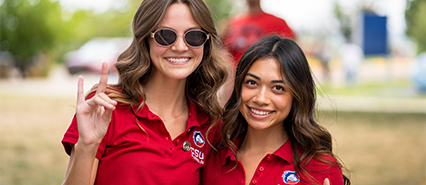CSU-Pueblo Students Further NASA Design
Release Date: April 25, 2019

Whether it’s first responders fighting a wildfire or hikers getting lost in the wilderness, the loss of communication can be the difference between life and death.
“This will boost the signal on your cellphone. If you are backpacking or hiking out in the wilderness, normally there would be no signal. But this will help,” said Kenneth “Kordell” Roberts while holding what looked like an ordinary green blanket with a giant silver oval in the middle of it.
But this blanket is far from ordinary. In fact, you can say it’s out of this world.
Roberts, a three-year industrial engineering student at Colorado State University-Pueblo and six other students have studied the NASA concept of a “portable wireless signal booster” and came up with their own idea on how to make a product with it.
Their idea earned them a trip to the NASA MITTIC Technology Transfer competition at the Johnson Space Center in March.
The students who worked on the project with Roberts are Alex Goodwin, Daniel Hoyle-Aguon, Connor Foust, Julian Fierro, Shermann Mcdermott and Wyatt Farris.
NASA rules only allowed four — Roberts, Goodwin, Hoyle-Aguon and Foust — to make the trip.
The objective was to design a commercially viable product by implementing one of NASA’s given intellectual properties, which included the signal booster.
“They gave us a list of 20 different types of IPs,” Roberts said.
Roberts received the competition’s Outstanding Leader Award.
The design is a stamped copper Fresnel lens woven between two sheets of water-resistant fabric. The product would be used as a passive antenna that is capable of boosting incoming electromagnetic signals, or radio waves, up to 10 decibels in areas of low coverage.
The CSU-Pueblo students’ concept would sew the signal booster into a waterproof nylon fabric that could easily be attached to outdoor gear or backpacks.
“We targeted more of search and rescue, wildfire firefighters and those types of markets where you would have a great need for something that was very lightweight and that was able to help increase your signal,” Roberts said.
“They are not going to want to carry an active signal boosting system, because those weigh 20, 30, 40 pounds. We thought it would be good to create a product that would be very lightweight that can also provide these benefits.”
The students were given a month to develop a 12-page concept paper which included planning and the development of a prototype. The students submitted it to NASA and they were selected in the top 10 and invited to the NASA facilities in Houston last month.
The students and their professor Jude DePalma spent four days touring the facility and networking with others in their field.
“We also continued to work on our prototype and the 10-minute presentation we did there. It was almost like a ‘Shark Tank’ pitch of the product we made,” said Foust, a second-year mechatronics engineering student at CSU-Pueblo.
“We were able to tour and to see a lot of the labs. We also had time to work and hear a lot of speakers.”
Goodwin, a second year mechatronics student, also participated in the competition. She said she was excited to see NASA projects.
“We got to see the mock-up of the international space station, the mock-up of the Orion (crew vehicle), a lot of the robotics that they were working on and all the different rockets,” Goodwin said.
Goodwin said one of the highlights was being able to see NASA’s neutral buoyancy lab, where they submerge mock-up parts of the international space station so astronauts can work and train for space walks while being weightless.
The buoyancy pool is the largest indoor pool in the country at 40 feet deep, 200 feet long and 100 feet wide.
“It was great to see the engineering right in front of us and not just something we just talk about all the time,” Goodwin said.
“What was really cool was we actually got to go down on the floor of these places where there were engineers and astronauts actually working and training,” Roberts chimed in.
Hoyle-Aguon, a second-year mechatronics student, said his favorite part was listening to guest speakers.
“It was really inspirational. They had robotics teams and such and they talked about their experiences of working at NASA and how they complete their tasks,” Hoyle-Aguom said.
“This is what we are learning towards and I wasn’t always in connection with that. This made it all seem more real. It’s something that any of us could be doing in the future ... This was a team effort.”
By being a top-10 finalist, each CSU-Pueblo team member also will have an opportunity to intern with NASA. Roberts, Hoyle-Aguon and Farris have been offered internships. Other students are waiting to hear if they will intern as well.
The group all agreed that the trip was one of the best experiences of their lives.
“It gave me the opportunity to go meet people and see things outside of what I see at school,” Roberts said.
“It was super transformative.”
DePalma said he was proud of his students.
“They were one of the 10 finalists and I think that is pretty cool. I think it’s neat that this university can provide those kind of opportunities to our engineering students,” DePalma said.
“I am happy that it was a great experience for all of them.”


